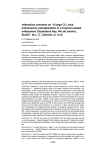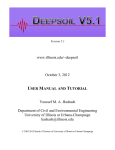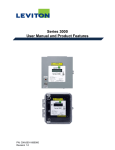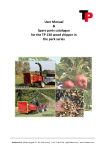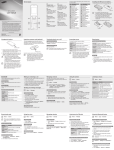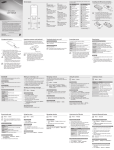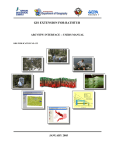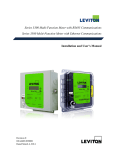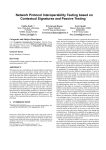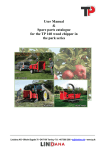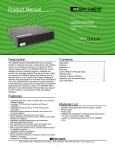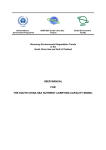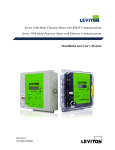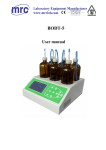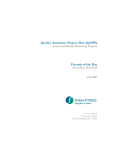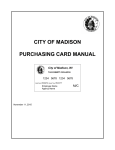Download Interactive comment on “A large CO2 sink enhanced by
Transcript
Biogeosciences Discussions Open Access Biogeosciences Discuss., 12, C3579–C3598, 2015 www.biogeosciences-discuss.net/12/C3579/2015/ © Author(s) 2015. This work is distributed under the Creative Commons Attribute 3.0 License. BGD 12, C3579–C3598, 2015 Interactive Comment Interactive comment on “A large CO2 sink enhanced by eutrophication in a tropical coastal embayment (Guanabara Bay, Rio de Janeiro, Brazil)” by L. C. Cotovicz Jr. et al. L. C. Cotovicz Jr. et al. [email protected] Received and published: 15 July 2015 Comment on “A large CO2 sink enhanced by eutrophication in a tropical coastal embayment (Guanabara Bay, Rio de Janeiro, Brazil)” by L. C. Cotovicz Jr. et al. Comment 1 General comments: The present paper under review for biogeosciences describes the surface water pCO2 and ancillary parameters in a semi-enclosed estuarine embayment. The paper gives interesting results (adding more studies of the carbon cycle in coastal area) and I recognize the sampling strategy effort done by the authors. It was also been really quick from the last sampling period to the submission so I congratulate the first author for this effort. There are not mistakes in the bibliography list C3579 Full Screen / Esc Printer-friendly Version Interactive Discussion Discussion Paper and spelling, attesting to the close attention the authors paid to writing. Reply1: Thank you very much for this general positive evaluation of our paper. Comment 2 However, I have three major concerns about the current version of the manuscript: 1. Statistical analysis need to be better explained and improved: Reply/Change2: In the revised MS, we have improved and explained in more details the statistical analyses, as recommended. We added a new section in the material and methods section called “2.4 Statistical Analysis”. However, we did not follow all the numerous and detailed comments by the reviewer#1 when he/she asked for more statistical analysis of our data. Indeed, in few cases (in particular for more quantitative biogeochemical analysis in the discussion section) we found that statistical analysis would not put additional value to our MS. To the contrary, as our MS was already quiet long, we had to make some choices in our revisions. In fact, we found more important to strengthen our “biogeochemical analysis” as asked by reviewer WJ Cai, rather than adding more statistical analysis that we believed would add limited value to our MS –the few Reviewer’s comments that were not accounted for are all detailed below. Nevertheless, important effort has been made for the description of statistics, and we recognize that these significant changes were necessary and greatly improved our MS. Comment 3 a. There is no section on the M&M on how the stats have been carried on, which program... Reply/Change3: We included a new section “Statistical Analysis” at the end of the Material and Methods, which includes the stats description, program, etc. Comment 4 b. P-values alone (e.g.: 4685, 1) do not provide any information (need to know which test. . .) Reply/Change4: Information on the statistical test for each p-value are now provided in the MS. Comment 5 c. “pCO2 correlated with DO” (4683, 26) need to know which correlation: Beware that standard regression is inappropriate as both variables are subject to errors. In such cases, one should use type 2 or geometric regression. Reply 5. In all C3580 BGD 12, C3579–C3598, 2015 Interactive Comment Full Screen / Esc Printer-friendly Version Interactive Discussion Discussion Paper experimental science, variables are subject to errors. What we want to discuss here is that because of respiration/photosynthesis, pCO2 was minimum when DO was maximum. Nothing more than this qualitative statement (for instance we don’t use the value of the slope of the regression in a quantitative way in order to calculate some kind of photosynthetic/respiratory quotients). . . Change 5. We used Spearman correlation and specified this in the text. Comment 6 d. “Trends that mirrored” (4672, 9) need a stats background. Reply 6. Same reply as for comment 5, see also figure R1 at the end of this comment, very classical trend in estuaries (Borges and Abril, 2011). Change 6 No change in the revised MS Comment 7 e. Authors used a PCA in section 4.2 that has not been introduced before. Moreover, PCA is a reduction technique, it does not show any correlation (maybe need to use a Multiple Linear Regression to show that.). . . Reply 7. We agree with the reviewer that PCA does not show correlations, but rather can shows patterns and finding patterns reducing the dimensions of the dataset through linear combinations. We used this analysis to make data easy to explore and visualize. We agree that Spearman Correlation matrix could also have been used in order to investigate the physical and biological controls CO2 dynamics. We did calculated this correlation matrix for the same the same variables of the PCA analysis (See Table R2 in the response to reviewers) and we obtained the same conclusion as with the PCA. In the interest of brevity, we have chosen to keep the PCA analysis in Figure 8 of our MS, but not to include the correlation matrix. If reviewer#1 and/or associated editor ask us to do so, we can include in the final version of the MS. Change7: we do not use the term “correlation” when we talk about the PCA. Comment 8 2. The paper talks a lot about residence times and net ecosystem production. I think the authors have everything they need to calculate both of these parameters and will increase the robustness of this really good paper. Reply8. Following the comment of both reviewers, we have used our pCO2 diurnal data to calculate net comC3581 BGD 12, C3579–C3598, 2015 Interactive Comment Full Screen / Esc Printer-friendly Version Interactive Discussion Discussion Paper munity production (NCP). We also added a new table that compares various carbon fluxes in Guanabara Bay responding to the comment of W-J Cai on biogeochemical analysis (See Table R3 in the final of this response). Concerning water residence time, we agree this affects the CO2 dynamics and air-water exchanges. However, in the case of Guanabara Bay, residence time is not always easy to estimate, if one wants to differentiate the residence time in each sectors. According to Kjerfve et al. (1997) the average renewal time of 50% of the bay water volume is 11.4 days, with important spatial variations (water renewal increasing seaward). So the average residence time (99% renewal of water) in the whole bay is probably around one month. Although we don’t know the exact value of residence time in each sector, we know that sectors S4 and S5 present the longest residence times compared to S1, which is connected to the ocean. So residence times vary between few days to one week in sector 1, and one month or more in sectors 4 and 5. We think that this semi-quantitative characterisation of residence time (together with stratification) still allows explaining most of CO2 spatial dynamics in Guanabara Bay. Change8: we calculated NCP, insert it in materials and methods, results and discussion, as well as, in the new table. Reference to residence time was made in a semi-quantitative approach as described above. Comment 9 3. Some question I had when I read the abstract and have not been answer are: a. Have the tide/tidal currents an effect in exchanging with open water? Reply 9/ The tide in the bay is semidiurnal with an average range of 0.7 m (micro/meso tidal). Generally, the tidal currents inside the bay are lower than 0.5 m/s (except near the bay entrance Kjerfve et al. (1997). With an average water tidal renewal of about one month, the tide/tidal currents effect in exchanging with open waters are relatively small. Change8: We mention the small impact of tidal exchange in the revised MS on the material and methods section. Comment 10 b. What is the influence of mangrove? This is really interesting point of the view of Koné et al. works. Reply 10. Indeed, mangrove-surrounding waters generally show large pCO2 supersaturation (eg Kone and Borges, 2008). In Guanabara Bay, C3582 BGD 12, C3579–C3598, 2015 Interactive Comment Full Screen / Esc Printer-friendly Version Interactive Discussion Discussion Paper the extension of mangrove forest is not so large, and the volume of water exchanged with the mangrove sediments is probably moderate. This is what our data suggest, as we could not find supersaturated pCO2 conditions near of the mangrove (2.5 - 3 km). This indicates little export, low tidal, probably associated with a rapid consumption of mangrove-derived DIC by the phytoplankton. Change9- we mentioned in the MS the low mangrove influence as suggested. Comment 11 c. Is there any other biological activity in the bay (seagrass, cultures, macrophytes. . .) Reply 11: Primary production in Guanabara Bay is dominated by phytoplankton. We not could find researches conducted in Guanabara Bay that accounts information about other biological activities like seagrass, macrophytes, etc. The bay presented poorly coverage of consolidate substrates, and does not provided ideal conditions for biological settlement other than plankton. Change 11: this is now mentioned in the “study site” section. Comment 12 d. What happens when the summer stratification break? Reply 12 As illustrated in figure 3, summer thermal stratification is diurnal and is weaker at night, due to convective cooling; in contrast, haline stratification maintains at night. We never observed in the field occurrence of summer stratification break along the sampling campaigns. Probably, the haline stratification can be broken during strong storms, which are not common for the region. The sectors 4 and 5 that showed the most prominent stratification are located in a confined and more protected region of the Bay, making the stratification break more difficult. In general, the stratification is weaker and driven by the strong PAR incidence (thermal stratification). Change12: No change in the MS related to this comment I use (page number, line number) or (section number) as in the friendly printed version of BDG to locate the comments Comment 13 Specific comments: Abstract: Here and elsewhere in the ms: Why the use of pCO2 units? Community normally use µatm. Reply/Change 12: There is no C3583 BGD 12, C3579–C3598, 2015 Interactive Comment Full Screen / Esc Printer-friendly Version Interactive Discussion Discussion Paper definitive convention for pCO2 unit and ppmv or µatm can be used. For instance, Nature journals impose the use of ppmv. Comment 14 (4672, 21-25): important message in a too long and confusing phrase. It’s not clear how the embayment is: classic, in contrast of what?? Here and elsewhere, emitter is a synonym of source? Please stick to sink/source to not confuse readers. It is scientific writing, not literature, do not be afraid of repetition (also in 4696, 15). Reply/Change 14: We have modified the text of this section in the abstract. Also, we replaced the term “emitter” to “source”. BGD 12, C3579–C3598, 2015 Interactive Comment Comment 15 Introduction: (4673, 25): no necessary comma before reference Reply/Change 15: Modified as suggested. Comment 16 (4673, 28): you don’t use GPP again so avoid excess of abbreviation. Reply/Change 16: Modified as suggested. Comment 17 (4674, 2): you haven’t defined what LOICZ stand for. In one of its manual, there’s a nice example on how to calculate residence times. Reply/Change 17: We defined the LOICZ abbreviation. Comment 18 Materials and methods: (4676, 11): “moderate stratified in wintertime”, do not look like that in your winter profiles, completely mixed. Reply/Change 18: We refer to “completely mixed” in the revised MS. Comment 19 Locate Ilha do Governador, Santos Dumont, Geleao in Fig. 1. Also add where the sea is, it took me a while to understand the situation (for non-knowers of the area) Reply/Change 19: We added all this information in Fig. 1 Comment 20 (4677, 24- ): if I read this paragraph first, it will be easier to understand the whole study area section. Right now it is difficult to know where the wide entrance, which is the inner regions. . . Reply/Change 20: figure 1 was improved as recommended, so it is location is easier now. Comment 21 (4678, 10): caution here and everywhere else where you talk about areas. C3584 Full Screen / Esc Printer-friendly Version Interactive Discussion Discussion Paper For example in (4684, 10) 75% of surface area of the Bay is wrong, is 75% of the sampled surface area of the Bay (67 % of the total area). Another example is (4697, 9-11): the polluted sampled area is only 10 % but the no sample 10 % might be also polluted (due to its location) and that will make 20 % of the bay. Modify Table 2 and Figure 6 a) accordingly (all/entire sampled bay) Reply/Change 21: We agree that 75 % and 10 % are related to the sampled area. We performed the modifications in the considered section, as well as, in table 2 and figure 6(a). BGD 12, C3579–C3598, 2015 Interactive Comment Comment 22 (4678, 29): is this probe also calibrated? Is the same as in (4679, 16)? Do you use discrete sample to calibrate for DO, temperature, salinity or only to converse chl a? Reply/Change 21: We calibrated the DO probe against saturated air. The temperature was not calibrated (we used 2 thermometers with very consistent results at +/- 0.01◦ C, one from the probe and from the pHmeter). The salinity probe was calibrated against certified material. Comment 23 There is an ongoing debate about influence on filter/no filter sampling for TA and DIC. Could you discuss some of this in your method? Did you test for this influence? Reply/Change 23: We measured TA on filtrated water, so we removed acidneutralizing particles. We did not test the difference between filtrated and non filtrated. We calculated DIC from pCO2 and TA. Comment 24 Which are pH and pCO2 accuracy/precision? How are the number of the verification (4679, 26)? How often did you calibrate the sensors? pCO2 span for long range, is the response still linear? How pCO2 data fits with SOCAT standards? Is there any plan to submit the dataset somewhere? Biogeosciences strongly promotes the full availability of the data sets reported in the papers that it publishes in order to facilitate future data comparison and compilation as well as meta-analysis. This can be achieved by uploading the data sets in an existing database and providing the link(s) in the paper. Reply 24 We used 3 gas mixture standards (410, 1007 and 5035 in ppmv) to calibrate C3585 Full Screen / Esc Printer-friendly Version Interactive Discussion Discussion Paper the LICOR before each sampling. We used N2 passing through fresh soda lime to set the zero, and we used the standard at 1007 ppmv to set the span. We used the second and third standards at 410 and 5035 ppmv to check linearity. The number of verifications after each calibration was about 7, the licor signal was stable and linear in the range of calibration. We also verify the drift before and after each sampling campaign. The measurements before and after each sampling campaign were consistent at precision level of about ± 3 ppmv. The excellent agreement between the verifications before and after each sampling campaign and the excellent agreement between the standards and the equipment shows that the method is robust and the pCO2 span is little. The precision and the accuracy of the pCO2 measurements were about 3 and 5 ppmv, respectively. The precision of the pH measurements was about 0.01 (after 7 verifications against NBS standards). We performed a three-point calibration (pH 4.01, pH 7.00 and pH 10.01). As we have overdetermined the carbonate system (pCO2, pH, and TA) and we have chosen to used direct pCO2 measurements and DIC calculated from pCO2 and TA, we use pH measurements only for quality check. Change 24: This is now specified in the materials and methods. Comment 25 (2.3.3) It is nice to try a small intercomparison between pairs but it need more quantifications (are the slopes statistically different from 1? Are the intercept statistically different from 0?) How are the errors propagated to calculate DIC? Is this ± 6.5 µmol kg-1 between calculated from each pair? Reply 25 With the biogeochemical analysis we make in this paper, we do not use DIC values to perform any budget calculation. We only use pCO2 values for the CO2 budget. Our paper is quiet long enough so we find such detailed DIC quality check secondary in comparison with other topics (eutrophication, stratification, etc. . .). Nevertheless, as requested, we provide to the reviewer the information on the quality of our data that in Figure R4 and we added few sentence in the material and methods. Change 25: We included this information on the DIC quality check in materials and methods. Comment 26 Results (3.1): - Are the sampling period statistically different than the C3586 BGD 12, C3579–C3598, 2015 Interactive Comment Full Screen / Esc Printer-friendly Version Interactive Discussion Discussion Paper climatology? Without stats is difficult to compare, for example, it seems to me summer period is not warmer and dryer that the average; from Fig. 2 there are 2 months with more rain that climatological and 3 dryer (same with temperature). Reply 26: The temperature variation of the sampling period was not different from the climatological regime (p > 0.05; test-t), except for Dec.2013 and Jan.2014 (p < 0.001; test-t). Especially for these two months, the period was significantly warmer than the average. Changes 26: We corrected the part of the text with this consideration. We included in the graphs the standard deviation bars. BGD 12, C3579–C3598, 2015 Interactive Comment Comment 27 - The “driest months” is August 2013 (otherwise state driest months during summer period). “precipitation consistent with historical data”: is that true? It seems Jul more rain and Aug really dry (4681, 24-26): We don’t have a table for seasonal variation so it’s difficult to follow last part (I miss this table in other part of the ms (i. e.: (4686, 8)), to allow easy follow) (4682, 5): “rainy season”, remain the reader when is that. Reply/Change27: We modified the text to “The other sampled months had air temperature and precipitation consistent with historical data (Fig. 2), despite of some deviations from the historical average.” It’s difficult to analyse the accumulated precipitation in this context because we didn’t use the accumulated precipitation of the month, instead, we used the accumulated precipitation of 7 days before each sampling campaign. Comment 28 (4682, 7): you haven’t defined what’s exactly eutrophic/hypertrophic and which are the threefold between both classifications. Readers might be familiars with eutrophic but hypertrophic is more rear. Reply/Change28: This classification was based on the classical Nixon’s classification (Nixon, 1995) of 4 trophic states, from oligotrophic (< 100 g Cm−2 yr−1) to hypertrophic (> 500 gCm−2 yr−1) according to the annual phytoplankton primary production. In this way, Guanabara Bay presented an overall classification of “eutrophic”, whereas sectors 4 and 5 can reach the classification of “hypertrophic” because the primary production can be higher than 500 gCm-2yr-1) (Rebello et al 1988). Change 27: We cite Nixon 1995 in the revised MS C3587 Full Screen / Esc Printer-friendly Version Interactive Discussion Discussion Paper Comment 29 (4682, 6-9): here is another example on how stats can help: cluster or any other grouping technique to show this difference between areas. Reply 29: we consider such cluster analysis would require a long description and would unnecessarily increase the length of the MS. Comment 30 (4682, 10): you haven’t defined SD before. Reply/Change 29: we define SD in the revised MS. Comment 31 (4682, 15): needs stats to highly or moderate associate something. Reply 31: Same reply as for comment 5. BGD 12, C3579–C3598, 2015 Interactive Comment Comment 32 (4682, 20-21): what do “outflow” and “inflow” means here? Reply/Change 32: We removed the words “inflow” and “outflow” in this context. Comment 33 (4682, 28): “well representative” is hard to believe on the light of such high diurnal changes. Were all done at the same time of the day? To avoid these doubts, it could be nice to have instead of one particular profile an average profile with mean and error bars. Reply/Change 33: These figures represent examples of depth profiles of Guanabara Bay, in summer and winter conditions, following the main channel of the Bay. The profiles were shown to illustrate the spatial and temporal differences in the vertical column water structure (corroborating with Kjerfve et al 1997 results), and also the diurnal enhancement of surface temperature in the upper parts of the bay. These profile are not supposed to be representative for any average conditions, they are used here to illustrate the dynamics of stratification in the bay. Comment 34 (4683, 27): temporally and spatially correlation need to sets of correlation values. Also defined what R2 is exactly. N in table 1 is different that n here? Please clarify/unify. Reply/Change 34: We performed the Spearman correlation. The r refers to the Spearman’s rank correlation coefficient. We corrected the N (now the N in the text is the same with that on the table). Comment 35 (4684, 2): unify the use of DO, AOU or Saturation (not defined) and use C3588 Full Screen / Esc Printer-friendly Version Interactive Discussion Discussion Paper the units accordanly (right now is DO with % not correct, also in table 1). Values of 3750 ppmv are not showed in fig (the scale didn’t arrive so high) Reply/Change 35: As stated in the material and methods, we report DO in % of saturation. The values in the scale were corrected. Comment 36 (4684, 6): “small and protected embayment” means S4, S5? Reply/Change 36: No. This is a small region of the sector 2. We deleted this part of the text to avoid confusion. BGD 12, C3579–C3598, 2015 Interactive Comment Comment 37 (4684, 15): here and elsewhere (also in figures) unify the date format. Can you clarify/rewrite brown/red bloom? I understand what you mean but I’m sure some biologist will have some concerns about that ⟞ Reply/Change 37: We unified the data format. Biologist Bastiaan Knoppers, has written this section and considers it is ok in its present form for such paper on carbon biogeochemistry Comment 38 (4684, 23): “open waters” might be misleading talking inside the bay. Reply/Change 38: We changed to the bay waters. Comment 39 (4684, 28): “In the latter” what? Sampling period, S1?? Reply/Change 39: “In the latter” referred to the back and forth track performed in S1. We rephrased this sentence. Comment 40 (4685, 1): talking about night time for early morning seems contradiction. Maybe use predawn? Reply/Change 40: We replaced nighttime to predawn. Comment 41 (4685, 4): here and elsewhere, please unify time threshold (sometimes is 9:00, 9:30, 10:00) Reply/Change 41: We unified the threshold as 9:30 AM. Comment 42 (4685, 5): you didn’t sample September 2014 Reply/Change 42: We changed to Sep.2013. Comment 43 (4685, 9): a reference is missing here. Reply/Change 43: We modified this part to “which apparently corresponded to the start hour of photosynthetic activity by phytoplankton”. It’s an “apparently” hour, and we don’t have a reference for this C3589 Full Screen / Esc Printer-friendly Version Interactive Discussion Discussion Paper specify. Rebello et al. 1988, for example, used 10:00 AM as the start of phytoplankton activity. BGD Comment 44 Unify how you write night time (if you are going to keep using it) Reply/Change 44: We unified to nighttime because is a common term in other studies. 12, C3579–C3598, 2015 Comment 45 (4685, 20): “diurnal variability”: I know is logistically difficult (or sometimes impossible) to do a proper night sampling. However, I would like to read something on explaining this caveat. You are claiming diurnal variation is important but you are still missing part of the day when even less data is available. Reply/Change 45: The night sampling was not proper performed mainly due to a problem of security. We heard about some problems with boat assaults in the upper parts of the bay (and related to drugs traffic), and we thought that anchor our boat in a point 24 hours maybe was not a good idea. Then, we thought about the sampling with boat in movement, from dawn to dusk. The sampling design was within our possibilities. Indeed, nighttime was less sampled than daytime. However, we believe that logically the early morning (predawn) corresponds to the maximum surface water pCO2, because of the long night period before. We also have a quiet precise sampling between 5:00 and midday, so we could observe rapid pCO2 decrease around 9-9:30 and then pCO2 becomes quiet stable at low values during the whole day Then, we have used multiple night end-members (except for S2), to diurnally integrate the fluxes. Interactive Comment Comment 46 (4685, 23-26): strange phrase, please rewrite more clear. Reply/Change 46: We modified as suggested. Comment 47 (4685, 26- 4686, 4): really long phrase for an important info. Also it will be nice to see this graph and have more quantification as it’s an important result, also present in the abstract. Reply/Change 47: We rephrased this part in the text. Also, we attached this graph (figure R1) in the final of this review. Furthermore, the figure 07and related discussion in the MS also provides information about this relationship. Comment 48 (4686, 5): more than 2000 in S4 during April 2014 is not “slight” ReC3590 Full Screen / Esc Printer-friendly Version Interactive Discussion Discussion Paper ply/Change 48: we removed slight. BGD Discussion Comment 49 (4689, 23): you haven’t defined PCA yet, not explain how you did. . . Reply/Change 49: We explained PCA in the material and methods section. Please see the reply/change 7. 12, C3579–C3598, 2015 Comment 50 (4690, 13): % of what, explain Reply/Change 50: We modified this part to “and showed the higher influence over the factor 2, which explained 19% of data variance.” Interactive Comment Comment 51 (4690, 19): 395 ?? units Reply/Change 51: Units are inserted. Comment 52 (4690, 28): discuss or take care of some organism are able to uptake bicarbonate by the enzyme carbonic anhydrase and by the proton pump mechanism Reply/Change 52: we insert in the text a sentence about this process according to Kirk, 2011. Kirk, J. T. O.: Light and photosynthesis in aquatic ecosystems, 3 ed., Cambridge University Press, New York, 2011. Comment 53 (4691, 25- 4692, 16): move to another section of the methods entitle “temperature and biological control in pCO2 calculations”. Clarify which means you are using: each survey independently or winter/summer as a whole. Explain the ratio (T/B = deltapCO2bio/deltapCO2temp) Reply/Change 53: We moved this text to the methods sections as suggested. We explained the ratio (T/B) in the new text, and the means were made for winter/summer as a whole. Comment 54 (4693, 26): how does the turbidity influence this? (same question in 4698, 5) Reply/Change 54: We did not fully understood this comment. In Guanabara Bay water are clear and the phytoplankton biomass itself creates most of the turbidity Comment 55 (4694, 11 and elsewhere): plankters = plankton? Reply/Change 55: Modified as suggested. Comment 56 (4694, 26): During this period, space missing Reply/Change 56: Modified as suggested. C3591 Full Screen / Esc Printer-friendly Version Interactive Discussion Discussion Paper Comment 57 (4697, 9-10): “However this region occupies only about 10 % of the surface area of the bay”. The other 10 % you could not sample seems logical to be also polluted. I understand the logistic problem but that will be now 20 % of the bay, just discuss the possible influence of the no sampled area. Reply/Change 57: S2 represents only 10 % of the sampled area. If we consider the unsampled region of sector 2, it still represents less than 10% of the area of the bay (because if we includes the unsampled area of this region in this context we also must include the other unsampled regions of the other sectors). We inserted in the text small discussion about this no sampled area. BGD 12, C3579–C3598, 2015 Interactive Comment Comment 58 (4697, 15): at daytime at nighttime?? Reply/Change 58: Modified as suggested. Conclusions Comment 59 (4698, 20): How can nutrient from sewage influence the whole bay but not carbon? Reply/Change 59: Because carbon is mineralized and evaded to the atmosphere in the sewage network, and in the high polluted channels. This is stated in two places in MS, as well as, the discussion about eutrophication and the conclusion Tables: Comment 60 1. Abbrevation of salinity (Sal.) has not been used during the ms. DO (%) wrong Reply/Change 60: Modified as suggested. Comment 61 2. How can U10 be different if they came only from 2 meteorological station (please clarify) Reply/Change 61:U10 are different because they come from 2 different meteorological stations, see material and method (4680, 4). For the sectors 1, 2 and 3 we used the data from meteorological station located at the Santos Dumont Airport, whereas for sector 4 and 5 we used the data from the Galeao Airport, located at the Governador Island (Figure 1). Figures: Comment 62 1. Dotted lines don’t seem dotted in my file. Missing South and West in lat/long to be able to locate the map. Reply/Change 62: We change to the “black line” instead of “dotted line”. We inserted South and West in lat/long of the C3592 Full Screen / Esc Printer-friendly Version Interactive Discussion Discussion Paper figure. BGD Comment 63 2. Dez? Mensal? Reply/Change 63: We modified the figure and we modified the caption as suggested. We also included the standard deviation bars. 12, C3579–C3598, 2015 Comment 64 3. Scales are different (also in 5) Reply/Change 64: the scales in the figures are different to better shows the results, and in the figure caption we took care to alert the reader about this. Interactive Comment Comment 65 4. Rainbow scales have been under debate not to use them. In (g) it’s really difficult to see where is super high (region 2) Reply/Change 65: We tested various color scales and used the best we found to show our data. Comment 66 5. Letters are small, difficult to read. In the small inner graphs, shadow when is “night time”. Legend >< 9:30 is confusing, better earlier, later (pre/post dawn?). Reply/Change 66: We increased the letters of the figure. We shadowed the small inner graphs. We modified to before 9:30 AM / after 9:30 AM Comment 67 6. Unify data format and 9:00 or 9:30? Reply/Change 67: We unified the data format to 9:30. Additional figure captions Figure R1: Relationship between pCO2(ppmv) vs. DO (%) for the continuous measurements of Guanabara Bay. N = 9002. Figure R2: Spearman correlation matrix for PAR (µmol m-2 s-1), accumulated precipitation of 7 days (Accum Prec 7; mm), wind velocity (Wind; cm s-1), dissolved oxygen (DO; %), chlorophyll a (Chl a; µg L-1), pCO2 (ppmv), salinity, temperature (Temp; ◦ C) and CH4 (nmol L-1) in the Guanabara Bay. The values were calculated with averages for each sampling campaign. Figure R3: Summary of the documented carbon fluxes in the Guanabara Bay. Figure R4: Linear Regression between DIC calculated from pH/TA and pCO2/TA. C3593 Full Screen / Esc Printer-friendly Version Interactive Discussion Discussion Paper (R2=0.994; Slope: 1.008 ± 0.006; slope significantly different from 0; p<0.0001). The slopes are not statistically different from 1 (p = 0.20) and the intercepts are not significantly different from 0 (p = 0.86). The method used is one equivalent to an Analysis of Covariance (ANCOVA), according to the GraphPad Guide User Manual 6.0. Interactive comment on Biogeosciences Discuss., 12, 4671, 2015. BGD 12, C3579–C3598, 2015 Interactive Comment Full Screen / Esc Printer-friendly Version Interactive Discussion Discussion Paper C3594 BGD 12, C3579–C3598, 2015 400 Interactive Comment DO (%) 300 200 100 0 0 1000 2000 3000 CO2 (ppmv) 4000 Full Screen / Esc Printer-friendly Version Interactive Discussion Discussion Paper Fig. 1. see caption in response text C3595 BGD 12, C3579–C3598, 2015 PAR Accum Prec 7 Wind Interactive Comment DO Chl a pCO2 Salinity Temp 0.11 0.83** 0.87** 0.87** -0.83** 0.02 0.68* PAR Accum 0.11 0.29 0.47 0.43 -0.46 -0.55 0.27 Prec 7 0.83** 0.29 0.88** 0.83** -0.91** -0.08 0.66 Wind 0.87** 0.47 0.88** 0.76* -0.93** -0.36 0.76 DO 0.87** 0.43 0.83** 0.76* -0.85** -0.06 0.60 Chl a -0.83** -0.46 -0.91** -0.93** -0.85** 0.38 -0.86** pCO2 0.02 -0.55 -0.08 -0.36 -0.06 0.38 -0.43 Salinity 0.68* 0.27 0.66 0.76* 0.60 -0.86** -0.43 Temp *Correlations significant at p < 0.05 ; **Correlations significant at p < 0.01 Full Screen / Esc Printer-friendly Version Interactive Discussion Fig. 2. see caption in response text Discussion Paper C3596 BGD 12, C3579–C3598, 2015 Inputs of carbon to Guanabara Bay CO2 air-water flux CO2 air-water flux mmol C m-2 d-1 Comment 26 – 49* 33 – 102* Organic carbon load from sewage 43 All bay average; This study Sectors 3, 4 and 5; This study, strong and permanent annual CO2 sink area All bay average; FEEMA (1998), majority of organic carbon seems to be mineralized in sewage network River DIC, DOC and TOC inputs Internal Processes NCP NPP Total Respiration Degassing / Burial / Export CO2 air-water flux Undocumented Total organic carbon burial 27 – 114 DIC and TOC export to the coastal area Undocumented mmol C m-2 d-1 51 – 225 (143)** 60 – 300 (170)** Undocumented mmol C m-2 d-1 54 – 177* Interactive Comment Comment Sectors 4 and 5; This study Sectors 2, 3 and 5; Rebello et al., (1988) Comment Sector 2; This study, permanent CO2 degassing in a restricted area Sectors 3, 4 and 5; Carreira et al., (2002) ; Monteiro et al., (2011) *Annual average according to the k600 model parameterizations of Wanninkhof (1992) and Abril et al., (2009). The lower value refers to the model of Wanninkhof (1992), whereas the higher value refers to the model of Abril et al. (2009); Full Screen / Esc ** Range and annual average (in parenthesis). Printer-friendly Version Interactive Discussion Fig. 3. see caption in response text Discussion Paper C3597 BGD DIC calculated from TA/pH 12, C3579–C3598, 2015 3000 Interactive Comment 2000 1000 0 0 1000 2000 3000 DIC calculated from TA/pCO2 Full Screen / Esc Printer-friendly Version Interactive Discussion Discussion Paper Fig. 4. see caption in response text C3598




















